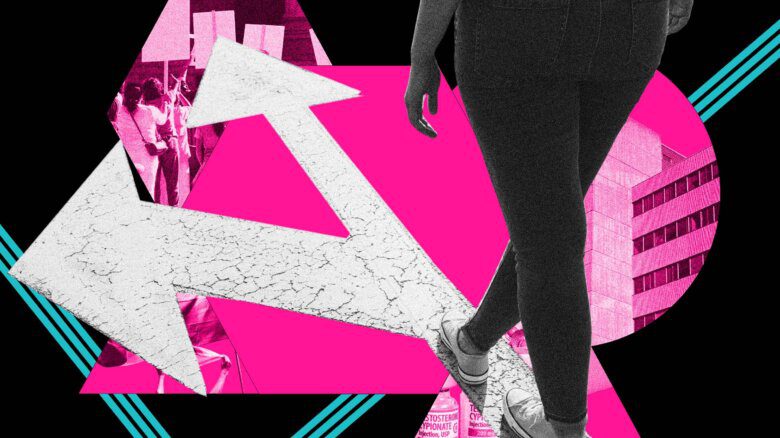
Credit: Courtesy of the Lesbian Herstory Archives
Buddy Kent was still gorgeous at age 70. She was even cuter in the 1940s, when she played the Club 181, located at 181 Second Ave on the Lower East Side of Manhattan, and the Moroccan Village, on 8th St in Greenwich Village.
Back then, downtown nightclubs like these, under the protection of the New York mob, featured floor shows with gay girls and boys performing in drag.
A visit to Buddy’s little apartment in the Village half a century later meant pulling out the old photo albums and poring over wonderful pictures of her and her fellow entertainers from the days before Stonewall.
There were eight-by-ten-inch close-ups of slender, wistful girls in white tie and tails or a tux, hair cut short and slicked back with Vitalis or Vaseline Hair Tonic. There were chorus lines of beautiful boys decked out like showgirls in feathers and sequins. And a blonde femme fatale in pale satin who was the resident stripper.
The shows were very professional in those days, the boys’ costumes designed by the same guys who worked for the Broadway musicals. A typical evening’s entertainment featured an opening number that set the theme for the show — Old Central Park, the Gay ’90s-with all the boys and girls in the cast. Performers like Buddy appeared in the chorus, then came back for their own act, maybe a dance routine with an old standard for accompaniment (“Button up your overcoat/when the wind blows free…”). Everyone came back for the grand finale.
“My world wasn’t the little gay bar with the beer on the corner,” Buddy (aka Malvina Schwartz of Brownsville, Brooklyn) said proudly. “It was showbiz, and very, very glamorous.”
“There was always a woman around,” she added.
I could see why. “Who’s that sitting next to you?” I asked about one photo.
“Oh, some hooker,” Buddy replied with a laugh. “All the big madams brought their girls down to the Village clubs looking for customers. That was when I was a chorus boy at the 181. Later on I had my own act.”
She showed me another picture of herself in tails and a top hat, cane in hand — a lesbian Fred Astaire.
“I was a hoofer,” she said. “I took classes uptown with Pearl Primus who’d just started her own dance company. I saw all the Broadway musicals, and borrowed steps for my routines.”
The next photo featured a gorgeous butch in a tux, with dark bedroom eyes and a come-hither smile.
“Now here’s Blackie Dennis,” Buddy explained. “She was a crooner who played the Moroccan Village. When some of us went over there from the 181, she didn’t like it. But then she figured out there was enough money to go around.”
Buddy paused. “Blackie didn’t have to worry after she met a society woman with a large trust fund who whisked her away to Florida where they raised poodles and soaked up sun.”
Big money turned out to be a recurrent theme in my chats with Buddy. On a good weekend, she said, she could make $100 or more in tips, a lot of moola for the 1940s.
“We made money, and we spent it,” Buddy said. “We bought clothes and cars. The bosses were rolling in it.”
The Mafia, of course, always did well giving people what they wanted, in this case a glimpse into a forbidden fantasy land of girls dressed up like boys, and boys dressed up like girls.
Despite big cover charges and high-priced drinks, customers lined up around the block to catch the 10:30pm, 12:30am and 2:30am performances.
While the shows were billed as just good fun — “Laffs, laffs, laffs” reads one old playbill — for many in the audience they were doubtless a sexual turn-on. Hookers cashed in, and entertainers could always earn a little extra cash for an after-hours romp with a regular or two.
“I never went to bed with anybody for money,” my good friend Gail had told me years before. Gail was another old-timer who’d played the Howdy Club on 8th St before World War II, the 181 in the 40s, then came back for a “hot minute” at the Club 82, corner of Second Ave and East 4th St in the mid-1950s.
We had shared many happy hours over her show biz photos, and I’d met most of the old performers, strippers and call girls I knew through Gail.
We used to gather in the backyard of her house on Long Island, on a quiet street where young couples raised children and trimmed lawns. Ours was not the typical suburban patio party. Nostalgia flourished with war stories about serving in the Women’s Army Corps or welding in the Brooklyn shipyards, and tall tales of the nightclubs where they had first met.
Gail, hair streaked with grey, would pull out her own photo album.
“That’s me at the 181,” she said.
Sure enough, it was Gail at 20-something, with soft blonde curls that gleamed under the stage lights and a chiseled profile like Errol Flynn’s.
At the time, I was a nice maiden-lady schoolteacher, and could tell right away that Gail had had a lot more fun in her youth than I was having in mine.
“The 181 was very plush, plush as the Copacabana,” she went on, “with a descending spiral staircase, red carpet, the works. The customers were straights and racketeers.”
The women, it seems, were not always so straight.
“They sent money up to me on stage, waited for me at the door!” Gail exclaimed. “I had to go out the back way to avoid them.” She sighed. “Boy, do I miss all that!”
After the clubs closed at 4am, everybody went to an after-hours joint, or to breakfast with all the Broadway celebrities at the original Reuben’s (the guy who invented the sandwich), on East 58th St just off Fifth Ave.
Gail liked to go up to Harlem to a place called Monroe’s Uptown. Buddy stayed in the Village at Ernie’s on 3rd St near Sullivan. Nobody slept till dawn.
On Sullivan St, too, there was a strip club called Jimmy Kelly’s, one of the oldest nightclubs in New York, whose original design was by a guy (probably gay) who did the Ziegfield Follies. It was at Jimmy Kelly’s that Buddy Kent became Bubbles Kent Exotic Dancer.
“Because I wanted to get in on some of the big money,” she told me at our first meeting, when she handed me a postcard. “Here, you can keep this. It’s an old publicity shot.”
Like a split screen, the card showed Buddy on the left in her white tie and tails, very elegant. “A breakaway costume,” she said. “The pants had snaps down the seams.” And on the right, Buddy looking absolutely stunning, stripped down to her lacy underwear. She was a knockout.
“This was when I played Jimmy Kelly’s, where The Fantastiks are now,” Buddy explained. The show later closed after a 40-year run in the Village.
“The manager didn’t want to hire me at first. He thought my act wouldn’t go over,” she recalled with a grin. “‘She’s a dyke!’ he told my manager Kicky Hall.
“‘Did you ever catch her act?’ Kicky asked him.
“Well, I was hired, and nobody ever complained. The men — high-rollers from Wall St — invited me back to their tables for a drink just like the other strippers. Most acts only lasted a few months at Jimmy Kelly’s. I stayed for a year.”
She turned to another photo. “Here’s Kicky with me and Jacquie Howe and a couple of kids. Everybody in the Village back then knew Jacquie Howe.”
She paused. “We owned this place in the photo called the Page Three. You can see it had a nice little intimate room where we had some good acts. Tiny Tim got his start at the Page Three.”
“Jacquie looks like FDR with that cigarette-holder,” I said.
“Oh, she was a real character.” Buddy smiled a loving smile. “If somebody had told me that Jacquie went to bed with Queen Elizabeth, I wouldn’t have been surprised! She’d been to bed with everybody else!”
“So you always felt safe in the Village?” I asked.
“It was home,” Buddy replied, “and we had the best protection in the world from the Mafia. They ran everything.”
“What about police raids? That was what Stonewall was all about.”
“The cops were paid off,” Buddy explained, “but sometimes they would raid a place if they got complaints, and close it down for a while. The Moroccan Village got closed down after somebody went nuts in there and shot up the place. But they opened up again after a couple of months.”
“Were you ever in a raid?” I asked.
“Yeah, in 1949 they raided the 181 because the neighbours had been complaining about seeing us go in to work in drag.” Buddy shrugged that off. “An unhealthy atmosphere for their kids, they said.”
“Did they take you down to the station?”
“No, I got out the back way. If they took you in, it was usually for ‘disturbing the peace’ or ‘impersonating’ somebody of the opposite sex, you know.” Buddy shook her head. “During the war they liked to pick up the boys in drag who were ‘preying on service men,’ they called it, pretending to be women.”
Buddy knew more stories than anybody — about playing in the Women’s Army Corps band during the war, about Eleanor Roosevelt when she lived in the Village, about who went with the hookers and who became hookers. I never tired of listening, and tried to persuade her that others would be enthralled too.
“This stuff is dynamite,” I said. “Don’t you think it’s about time we wrote some of it down?”
“All that was a hundred years ago. Nobody wants to hear about it.” She thought for a minute. “And the people who ran the clubs don’t like publicity.”
“They must all be gaga or at the bottom of the river by now,” I argued. “And they wouldn’t care anyway. They make movies about them now.”
“This wasn’t a movie, sweetheart,” Buddy cautioned. “This was the real thing.”
Buddy’s gone now. Gail is 86 and coping with Florida hurricanes.
We have a few authentic photos from those times mainly because they were coerced into giving them up. Buddy was always worried about embarrassing her family, her nephews who were “professional men” (dentists).
And the code of the underworld — gay and otherwise — was silence plus loyalty. You got no photos that might expose gay and lesbian friends. Gail carefully cut other people out of the photos of herself. Buddy reclaimed a couple of photos when she found out those depicted weren’t dead.
Stories and images get lost. If family members come in at the end, they don’t know what to do with the stuff, or want to get rid of it quickly.
Fortunately, archival collections are trying to preserve this heritage: the Lesbian Herstory Archives in Brooklyn, the Canadian Lesbian And Gay Archives in Toronto, the GLBT Historical Society in San Francisco, the One Institute and Archives, the International Gay And Lesbian Heritage/Research Center in Los Angeles and the June L Mazer Lesbian Archives, also in Los Angeles. A new collection is in the making in Seattle as the Pacific Northwest Lesbian Archives.
We owe it to ourselves to collect, preserve and keep these stories alive. If for no other reason, just because they are so much fun.

 Why you can trust Xtra
Why you can trust Xtra


